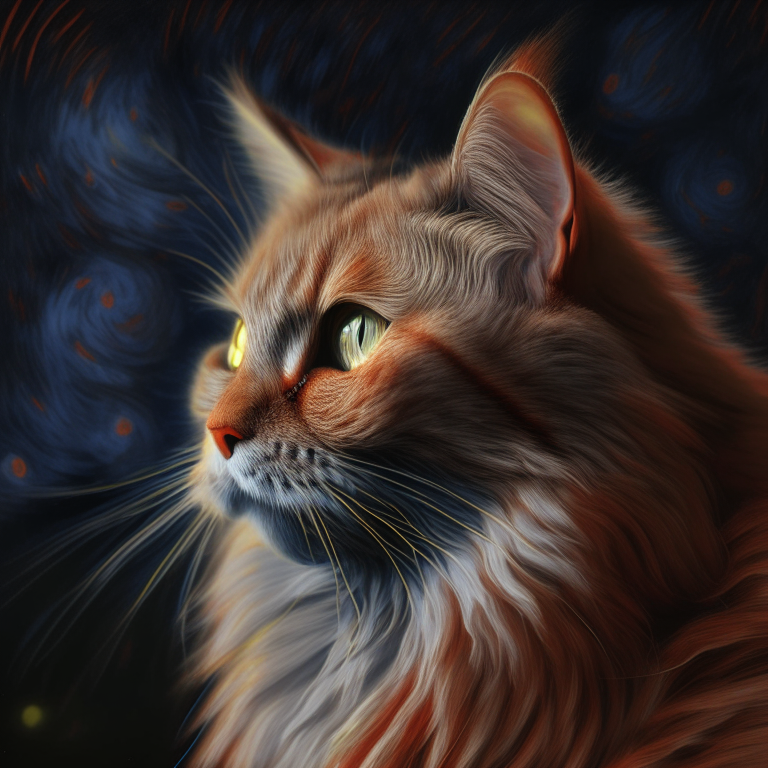Kandinsky 2.2 image mixing (interpolation) is a text-conditional diffusion model based on unCLIP and latent diffusion, composed of a transformer-based image prior model, a unet diffusion model, and a decoder.
Note: This algorithm requires 10GB GPU RAM
We strongly recommend using a virtual environment. If you're not sure where to start, we offer a tutorial here.
pip install ikomiafrom ikomia.dataprocess.workflow import Workflow
from ikomia.utils.displayIO import display
# Init your workflow
wf = Workflow()
# Set input images to mix
wf.set_image_input(
url="https://huggingface.co/datasets/hf-internal-testing/diffusers-images/resolve/main/kandinsky/cat.png",
index=0
)
wf.set_image_input(
url="https://huggingface.co/datasets/hf-internal-testing/diffusers-images/resolve/main/kandinsky/starry_night.jpeg",
index=1
)
# Add algorithm
algo = wf.add_task(name = "infer_kandinsky_2_image_mixing", auto_connect=True)
algo.set_parameters({
'prompt': 'a cat',
'negative_prompt': '',
'prior_num_inference_steps': '25',
'prior_guidance_scale': '4.0',
'num_inference_steps': '100',
'guidance_scale': '4.0',
'weights': '[0.3, 0.3, 0.4]',
'seed': '1231689',
'width': '768',
'height': '768',
})
# Run
wf.run()
# Display the image
display(algo.get_output(0).get_image())Ikomia Studio offers a friendly UI with the same features as the API.
-
If you haven't started using Ikomia Studio yet, download and install it from this page.
-
For additional guidance on getting started with Ikomia Studio, check out this blog post.
- prompt (str) - default 'a cat' : Text prompt to guide the image generation .
- negative_prompt (str, optional) - default '': The prompt not to guide the image generation. Ignored when not using guidance (i.e., ignored if
guidance_scaleis less than1). - prior_num_inference_steps (int) - default '25': Number of denoising steps of the prior model (CLIP).
- prior_guidance_scale (float) - default '4.0': Higher guidance scale encourages to generate images that are closely linked to the text prompt, usually at the expense of lower image quality. (minimum: 1; maximum: 20).
- num_inference_steps (int) - default '100': The number of denoising steps. More denoising steps usually lead to a higher quality image at the expense of slower inference.
- guidance_scale (float) - default '1.0': Higher guidance scale encourages to generate images that are closely linked to the text prompt, usually at the expense of lower image quality. (minimum: 1; maximum: 20).
- weights (list) - default '[0.3, 0.3, 0.4]': list of weights for each condition in images_and_prompts [prompt, image 1, image 2]
- height (int) - default '768: The height in pixels of the generated image.
- width (int) - default '768: The width in pixels of the generated image.
- seed (int) - default '-1': Seed value. '-1' generates a random number between 0 and 191965535.
note:"prior model" interprets and encodes the input text to understand the desired image content, while the "decoder model" translates this encoded information into the actual visual representation, effectively generating the image based on the text description.
from ikomia.dataprocess.workflow import Workflow
from ikomia.utils.displayIO import display
# Init your workflow
wf = Workflow()
# Set input images to mix
wf.set_image_input(
url="https://huggingface.co/datasets/hf-internal-testing/diffusers-images/resolve/main/kandinsky/cat.png",
index=0
)
wf.set_image_input(
url="https://huggingface.co/datasets/hf-internal-testing/diffusers-images/resolve/main/kandinsky/starry_night.jpeg",
index=1
)
# Add algorithm
algo = wf.add_task(name = "infer_kandinsky_2_image_mixing", auto_connect=True)
algo.set_parameters({
'prompt': 'a cat',
'negative_prompt': '',
'prior_num_inference_steps': '25',
'prior_guidance_scale': '4.0',
'num_inference_steps': '100',
'guidance_scale': '4.0',
'weights': '[0.3, 0.3, 0.4]',
'seed': '1231689',
'width': '768',
'height': '768',
})
# Run
wf.run()
# Display the image
display(algo.get_output(0).get_image())Every algorithm produces specific outputs, yet they can be explored them the same way using the Ikomia API. For a more in-depth understanding of managing algorithm outputs, please refer to the documentation.
from ikomia.dataprocess.workflow import Workflow
# Init your workflow
wf = Workflow()
# Add algorithm
algo = wf.add_task(name="infer_kandinsky_2_image_mixing", auto_connect=True)
# Run on your image
wf.run()
# Iterate over outputs
for output in algo.get_outputs():
# Print information
print(output)
# Export it to JSON
output.to_json()




